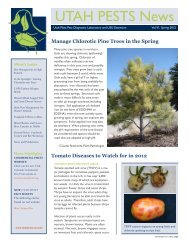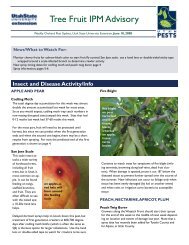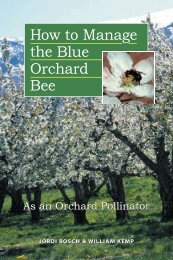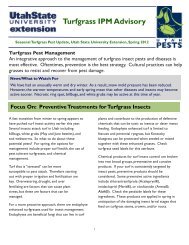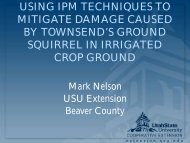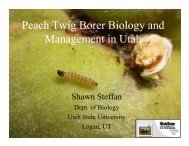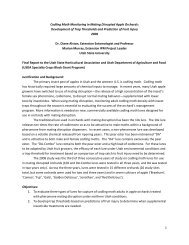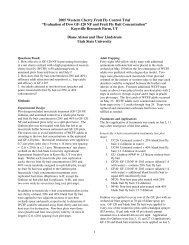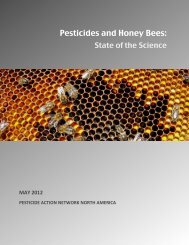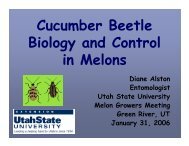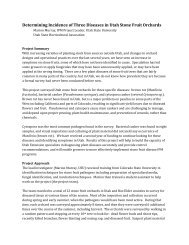Onion Thrips: Contributions of Life Stage Survival and Adult ...
Onion Thrips: Contributions of Life Stage Survival and Adult ...
Onion Thrips: Contributions of Life Stage Survival and Adult ...
Create successful ePaper yourself
Turn your PDF publications into a flip-book with our unique Google optimized e-Paper software.
<strong>Onion</strong> <strong>Thrips</strong>:<br />
<strong>Contributions</strong> <strong>of</strong> <strong>Life</strong> <strong>Stage</strong><br />
<strong>Survival</strong> <strong>and</strong> <strong>Adult</strong> Dispersal to<br />
Populations on Plants<br />
Diane Alston<br />
Entomologist<br />
Utah State University Extension<br />
2007 Utah <strong>Onion</strong> Association Meeting
Why are onion thrips such a pest<br />
◘ <strong>Life</strong> history <strong>and</strong> ecology<br />
well-adapted to onions<br />
◘ Females reproduce asexually<br />
(parthenogenesis)<br />
◘ Short generation time (2-3<br />
wk)<br />
◘ High mobility <strong>of</strong> adults<br />
◘ Rapid development <strong>of</strong><br />
resistance to insecticides<br />
◘ <strong>Life</strong> stage survival strategies<br />
◘ Later larval instars are nonfeeding<br />
& protected<br />
◘ Eggs are protected – females<br />
insert them into leaf tissue
<strong>Thrips</strong> sampling tools<br />
1.Whole plant<br />
wash<br />
2. Stain 3 rd<br />
leaf<br />
3. Aerial sticky<br />
traps<br />
Egg<br />
Larva <strong>Adult</strong> <strong>Adult</strong>
<strong>Thrips</strong> <strong>Survival</strong> vs. Immigration<br />
Immediately after<br />
insecticides were applied<br />
3 treatments:<br />
1.Open plants (allow immigration<br />
& natural enemies)<br />
2.Cage plants (exclude immigrants<br />
& natural enemies)<br />
3. Spray with soap <strong>and</strong> cage<br />
plants (remove motile stages<br />
& exclude new immigrants)
Importance <strong>of</strong> egg survival<br />
Influence <strong>of</strong> exclusion (caging) on onion thrips<br />
populations on plants 2 wk after insecticides<br />
2006<br />
60<br />
50<br />
Mean #<br />
thrips per<br />
plant<br />
40<br />
30<br />
20<br />
Open<br />
Caged<br />
Soap-Caged<br />
10<br />
0<br />
Untreated<br />
Insecticide-<br />
Treated<br />
Egg survival<br />
was more<br />
important<br />
than new<br />
immigrants
Importance <strong>of</strong> egg survival<br />
Mean number <strong>of</strong> hatched onion thrips per leaf<br />
Influence <strong>of</strong> insecticides on hatching <strong>of</strong> onion<br />
thrips eggs, 1 <strong>and</strong> 2 wk after insecticides<br />
2006<br />
30<br />
25<br />
20<br />
15<br />
10<br />
5<br />
0<br />
Success Carzol Warrior Surround 2% Stylet<br />
Oil<br />
1% Stylet<br />
Oil<br />
Untreated<br />
*1% Stylet oil added to Success, Carzol, <strong>and</strong> Warrior treatments<br />
1 week<br />
2 weeks<br />
Cumulative<br />
totals <strong>of</strong><br />
6-28<br />
hatched<br />
larvae<br />
per leaf
Composition <strong>of</strong> thrips populations on<br />
plants (2005-06)<br />
<strong>Life</strong> stage on plant<br />
Eggs in leaves<br />
% composition <strong>of</strong> total<br />
population<br />
60-75%<br />
Larvae in neck<br />
15-30%<br />
<strong>Adult</strong>s in neck<br />
1-3%*<br />
*<strong>Adult</strong>s are underrepresented in whole plant wash samples
Importance <strong>of</strong> Immigrating <strong>Adult</strong>s<br />
Mean # adult thrips per trap per day<br />
Influence <strong>of</strong> insecticides on onion thrips adult<br />
dispersal: before compared to after<br />
insecticides (2006)<br />
700<br />
600<br />
500<br />
400<br />
300<br />
200<br />
100<br />
0<br />
* *<br />
Success Carzol Warrior Surround 2% Stylet<br />
Oil<br />
3 wk Before 3 wk After<br />
1% Stylet oil added to Success, Carzol, <strong>and</strong> Warrior treatments<br />
*<br />
*<br />
1% Stylet<br />
Oil<br />
Untreated
Conclusions on importance <strong>of</strong> life<br />
stage survival <strong>and</strong> adult dispersal<br />
◘ Eggs are a main contributor to<br />
populations on plants (hatch in 1-2<br />
wk)<br />
◘ Egg survival <strong>and</strong> immigrating adults<br />
following insecticide applications help<br />
perpetuate the population on onions<br />
◘ Suppression strategies: include<br />
prevention <strong>of</strong> egg-laying <strong>and</strong> hatch
2006 Insecticide Efficacy Trial<br />
2006 Kaysville <strong>Onion</strong> <strong>Thrips</strong> Biology <strong>and</strong> Control Trial<br />
North<br />
Block 4<br />
Block 3<br />
5<br />
2<br />
4<br />
1<br />
2<br />
4<br />
3<br />
6<br />
7<br />
7<br />
3<br />
1<br />
5<br />
6<br />
Treatments (flag colors):<br />
1. Success + 1% Stylet Oil (orange)<br />
2. Carzol + 1% Stylet Oil (orange str)<br />
3. Warrior + 1% Stylet Oil (pink)<br />
4. Surround (pink stripe)<br />
5. 2% Stylet Oil (blue)<br />
6. 1% Stylet Oil (white stripe)<br />
7. Untreated (white)<br />
Block 2<br />
Block 1<br />
1<br />
3<br />
5<br />
1<br />
6<br />
4<br />
7<br />
3<br />
2<br />
2<br />
6<br />
5<br />
7<br />
4<br />
7 treatments x 4 blocks = 28 plots<br />
Plot size:<br />
15 ft (5 beds) x 20 ft<br />
5 ft buffer in front <strong>and</strong> behind each<br />
plot<br />
Dirt Road <strong>and</strong> Irrigation Line
2006 Insecticide Efficacy Trial<br />
1. Success 6 oz/acre + 1% Stylet Oil<br />
2. Carzol SP 0.75 lb/acre + 1% Stylet<br />
Oil (not registered)<br />
3. Warrior 3 fl oz/acre + 1% Stylet<br />
Oil<br />
4. Surround WP 25 lb/acre<br />
5. 2% Stylet Oil<br />
6. 1% Stylet Oil<br />
7. Untreated Control
Insecticide efficacy – Kaysville Research Farm<br />
Motile thrips (<strong>Adult</strong>s <strong>and</strong> Immatures)<br />
July, 2006<br />
Mean # thrips per plant<br />
120<br />
100<br />
80<br />
60<br />
40<br />
20<br />
0<br />
*<br />
*<br />
Success<br />
Carzol<br />
Warrior<br />
Surround<br />
2% Stylet Oil<br />
1% Stylet Oil<br />
Untreated<br />
Pre 7 d 14 d<br />
Days after treatment<br />
1% Stylet oil added to Success, Mustang, <strong>and</strong> Diatect treatments
Insecticide efficacy – Kaysville Research Farm<br />
Eggs in Leaves<br />
July, 2006<br />
Mean # eggs per leaf<br />
40<br />
35<br />
30<br />
25<br />
20<br />
15<br />
10<br />
5<br />
0<br />
Egg<br />
*<br />
*<br />
Success<br />
Carzol<br />
Warrior<br />
Surround<br />
2% Stylet Oil<br />
1% Stylet Oil<br />
Untreated<br />
Pre 7 d 14 d<br />
Days after treatment<br />
1% Stylet oil added to Success, Mustang, <strong>and</strong> Diatect treatments
Where do we go from here<br />
◘ Healthy, nonstressed<br />
plants<br />
◘ Resistant/tolerant<br />
cultivars<br />
◘ Prevention <strong>of</strong> egglaying<br />
& hatch<br />
◘ Systemics, ovicides,<br />
larvicides<br />
◘ Protectants that<br />
repel oviposition<br />
Morgan Reeder field on 2006<br />
Tour<br />
Research




